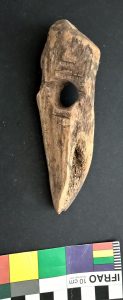01 Oct Use-wear analysis of the bone and antler artefacts
Traceology or microscopic use-wear analysis is an archaeological method, which, with a help of a microscope, looks for characteristic traces of usage on surfaces of tools. Sometimes it can help to find also some specific traces of a damage or residua, which can help to determine a function of a tool. English terminology of this discipline is still not precisely defined and all the terms such as use-wear analysis, microwear analysis or traceology are used as a name of this analysis.
Traceology as the archaeological method uses a microscopic analysis of use-wear traces (such as gloss, striation or edge damages) and analysis of residua on tool surfaces for interpretation of probable function of a tool.
Tool surface modifications (so called use-wear traces), originating during the mechanical-chemical interaction between a tool and a processed material, are the main subject of the research. Further, this discipline studies rules connected to a mechanism of use-wear origin and to its development on various raw materials used for a tool production, origin of post-depositional modifications of analysed tools, preservation of use-wear in different environments, variability and distinguishability of use-wear according to different kinds of used raw material etc.
Experiment is an inseparable part of the traceology. Experimentally obtained use-wear traces can help with an interpretation of traces found on archaeological finds, but usually they can not help with the identification of the used material.
In the ERCA Centre the use-wear analyses of bone and antler artefacts are guaranteed by RNDr. Miriam Nývltová Fišáková, PhD.

Antler pick bearing some use-wear traces. Photo by M. Nývltová Fišáková.





